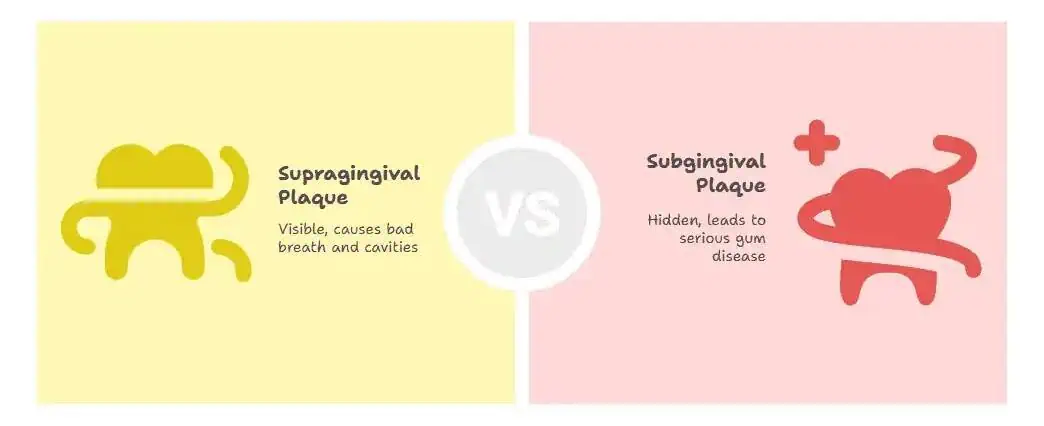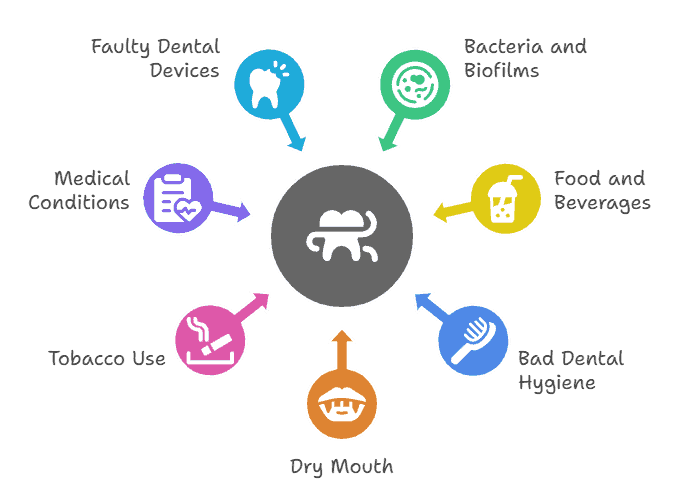Key Takeaways: Dental Plaque: Causes, Symptoms, and How to Remove it
- Dental plaque is a sticky film of bacteria that forms daily on teeth and gums.
- If not removed, plaque hardens into tartar and increases the risk of cavities, gum disease, and even health conditions like diabetes and heart disease.
- Common symptoms include fuzzy teeth, bad breath, bleeding gums, tooth sensitivity, and discoloration.
- Professional dental cleanings and good daily habits like brushing, flossing, and rinsing are the best ways to remove and prevent dental plaque.
- Coral Dental Care offers expert dental cleanings to keep your smile plaque-free and healthy.
Dental plaque is a sticky, colorless film that naturally forms on teeth and gums. While it may seem harmless at first, untreated plaque can harden into tartar, cause cavities, and even lead to gum disease.
The good news is that with the right care, plaque is manageable and preventable. This guide walks you through everything you need to know about dental plaque, including what it is, why it forms, how to get rid of it, and the best ways to protect your smile.
What is Dental Plaque?
Dental plaque is a bacterial coating that is soft and sticky. It constantly forms on your teeth and along the gumline. When you eat or drink foods containing sugars and starches, bacteria feed on them and release acids. These acids weaken enamel and irritate gums. If left unchecked, it can lead to cavities, gingivitis, and other dental problems.
What is Dental Plaque Made Of?
Dental plaque may look like a thin, transparent film, but it’s actually made up of various items, including bacteria, food remains, saliva, and more:
- Bacteria: Both good and bad bacteria live in your mouth. The harmful strains thrive on sugar and cause decay.
- Food Particles: Sugary and starchy food debris gets trapped between teeth and contributes to plaque growth.
- Saliva Proteins: Natural proteins from saliva mix with bacteria to form a sticky biofilm that clings to teeth.
This mix creates a perfect environment for bacteria to multiply, which is why regular brushing and flossing are so important.
What are the Different Types of Dental Plaque?

- Supragingival Plaque: Found above the gums, this plaque is often visible as a soft, whitish or yellowish film on teeth. It causes bad breath, tooth discoloration, and cavities if not removed.
- Subgingival Plaque: This type forms under the gums, inside the pockets around your teeth. It’s harder to see and clean, but it’s more harmful because it contributes to serious oral health conditions, such as gingivitis and periodontal disease.
What Causes Dental Plaque?
Plaque buildup isn’t caused by just one factor. It’s influenced by diet, oral hygiene habits, and even overall health. Here are its main causes:
- Bacteria and Biofilms: Harmful bacteria naturally attach to teeth and form sticky layers, known as biofilms, which grow into plaque.
- Food & Beverages: Consuming sugary drinks, sweets, and refined carbs provides bacteria with food that accelerates plaque buildup.
- Bad Dental Hygiene: Skipping brushing or flossing allows plaque to remain on teeth, where it quickly hardens.
- Dry Mouth: Saliva helps wash away food and bacteria. Conditions that reduce saliva flow, like certain medications, increase plaque risk.
- Chewing Tobacco and Smoking: Tobacco lowers saliva production and encourages extreme dental plaque buildup.
- Medical Conditions: GERD, radiation therapy, and other health issues can create an environment where plaque thrives.
- Faulty Dental Devices or Old Fillings: Ill-fitting crowns, bridges, or orthodontic appliances provide rough surfaces where plaque sticks more easily.
What Are the Alarming Symptoms of Dental Plaque?
Plaque often develops quietly, but as it accumulates, your teeth and gums begin to show noticeable changes. Here are the most common red flags to watch out for:
- Rough or Coated Teeth: After meals, your teeth may feel fuzzy or gritty instead of smooth, which is a telltale sign of plaque buildup.
- Persistent Bad Breath: Yes, dental plaque can cause bad breath! A lingering odor, also called halitosis. This smell often points to bacteria thriving on your teeth and gums.
- Gums That Bleed Easily: If your gums bleed when brushing or flossing, it may indicate early gum irritation caused by plaque.
- Heightened Tooth Sensitivity: Hot, cold, or sweet foods may trigger discomfort as plaque starts to weaken the protective enamel.
- Dull or Stained Teeth: Plaque accumulation can make teeth lose their natural shine, leaving them looking yellowish or discolored.
If you recognize any of these symptoms, don’t ignore them. Acting early can stop plaque from hardening into tartar and protect your long-term oral health.
What Happens if You Don’t Remove Dental Plaque?
When plaque is ignored, it doesn’t just stay on the surface of your teeth. It can harden and spread bacteria into your gums and even affect your overall health. Here’s what can happen:
- Gingivitis and Gum Disease: Plaque buildup irritates gums, leading to gingivitis, gum bleeding, and eventually periodontitis.
- Heart Disease: Bacteria from the mouth can travel into the bloodstream and impact heart health.
- Dementia: Studies link advanced gum disease bacteria with memory decline and Alzheimer’s risk.
- Tartar Development: Untreated plaque hardens into dental tartar, which can only be removed by a dentist.
- Premature Birth: Pregnant women with gum disease are more likely to deliver early.
- Chronic Inflammation: Long-term gum disease triggers inflammation that affects the immune system.
- Diabetes: Plaque-related gum disease makes it harder to manage blood sugar levels.
- Tooth Infections: Extreme dental plaque buildup can lead to decay, abscesses, and painful toothaches.
- Rheumatoid Arthritis (RA): Chronic inflammation from gum disease can worsen arthritis symptoms.
How to Remove Dental Plaque: Treatment Options
The good news is that plaque can be managed by dental self-care and good daily habits. If required, you can also get rid of plaque with professional treatments.
-
Professional Cleaning
Dentists use advanced tools such as dental scrapers for plaque removal. Ultrasonic devices and polishing techniques are also used to remove both plaque and tartar safely. Professional cleanings are recommended as effective dental plaque treatments which need to be done every six months, or more often if you have recurring buildup.
-
At-Home Remedies
Good oral hygiene practices are your first line of defense. Here are some of the best home remedies to remove dental plaque:
- Brush at least twice a day using fluoride toothpaste.
- Floss daily to remove plaque from between teeth.
- Rinse with an antibacterial or dental plaque removal mouthwash.
- Use a water flosser or interdental brushes for extra cleaning if needed.
- Some people use a dental plaque removal tool at home. However, they should be used cautiously and never as a substitute for professional cleanings.
How Can You Prevent the Formation of Dental Plaque on Gums & Teeth
Prevention is easier than treatment. Brushing, flossing, and rinsing are the prerequisites to clean dental plaque and prevent its buildup:
- Brushing: Use a soft-bristle brush and fluoride toothpaste, brushing for at least two minutes twice daily.
- Flossing: Clean between teeth daily to remove food debris and bacteria.
- Rinsing: Swish with an antibacterial or fluoride mouthwash to reduce bacteria.
- Healthy Diet: Limit sugary snacks and drinks that feed bacteria.
- Regular Dental Visits: Schedule professional cleanings to stay ahead of plaque and tartar.
Dental Plaque vs. Dental Tartar
While often confused, dental plaque and tartar are not the same:
- Plaque: It is a soft, sticky layer of bacteria that can be removed at home with brushing and flossing.
- Tartar: It is the hardened plaque that forms when plaque isn’t cleaned off. Tartar bonds to teeth and requires professional dental tools for removal.
Read more: Dental Tartar: Causes, Signs, and Treatment Options
Keep Your Smile Bright & Healthy
Don’t let plaque or tartar take over your teeth. At Coral Dental Care in Salem, MA, our expert team is here to help you protect your oral health with gentle, professional cleanings.
Call us today or book your appointment online to enjoy a cleaner, healthier smile.
Frequently Asked Questions
-
How common is plaque?
Everyone has plaque that gets cleaned daily by brushing and flossing. You may have accumulated plaque if you feel a fuzzy layer on your teeth while running your tongue over them.
-
Who is more likely to get plaque?
Excessive plaque can develop on the teeth of people who indulge in sugary, starchy, and fatty foods. Smoking, anti-depressant medication that causes dry mouth, and radiation also lead to plaque on teeth.
-
How do I know if I have Plaque?
A fuzzy feeling on your teeth when you run your tongue over your teeth indicates plaque. You can also look out for the symptoms mentioned earlier in this post.
-
How does plaque appear on teeth?
The dental plaque looks like a yellow or pale layer on your teeth. You can first spot it between the surfaces of the teeth. If not removed, it gradually progresses all over the teeth and around the gum line.
-
When should I call the doctor?
You should contact your doctor once you spot early signs of tartar or plaque accumulation on teeth, such as a yellow or brownish hard layer on teeth, tender gums, bad breath, swollen and bleeding gums. The more problematic symptoms include facial swelling, loose teeth, and toothache.

Dr. Anu Isaac, DMD, runs a successful dental practice in Salem, MA. Dr. Isaac strives for quality on a daily basis and this commitment to quality is reflected in her constant pursuit of advanced training. Her firm belief that even experts need to stay updated about what’s new in the dental field, enables her to provide every patient with optimal oral care. As the founder of Coral Dental Care, she is dedicated to creating healthy, beautiful smiles for her patients and also to educating dental and non-dental community with her engaging articles on all things related to oral health, recent dental innovations, and latest treatment modalities.





